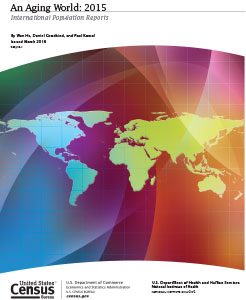An Aging World: 2015
By Wan He, Daniel Goodkind, and Paul Kowal, March 2016
The world population continues to grow older rapidly as fertility rates have fallen to very low levels in most world regions and people tend to live longer. When the global population reached 7 billion in 2012, 562 million (or 8.0 percent) were aged 65 and over. In 2015, 3 years later, the older population rose by 55 million and the proportion of the older population reached 8.5 percent of the total population. With the post World War II baby boom
generation in the United States and Europe joining the older ranks in recent years and with the accelerated growth of older populations in Asia and Latin America, the next 10 years will witness an increase of about 236 million people aged 65 and older throughout the world. Thereafter, from 2025 to 2050, the older population is projected to almost double to 1.6 billion globally, whereas the total population will grow by just 34 percent over the same period.
Yet the pace of aging has not been uniform. A distinct feature of global population aging is its uneven speed across world regions and development levels. Most of the more developed countries in Europe have been aging for decades, some for over a century. In 2015, 1 in 6 people in the world live in a more developed country, but more than a third of the world population aged 65 and older and over half of the world population aged 85 and older live in these countries. The older populations in more developed countries are projected to continue to grow in size, but at a much slower pace than those in less developed countries, particularly in Asia and Latin America. By 2050, less than one-fifth of the world’s older population will reside in more developed countries.



